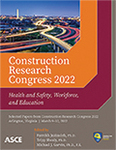Comprehensive Analysis on the Adoption of the Multiskilling Strategy among Craft Professionals
Publication: Construction Research Congress 2022
ABSTRACT
Studies suggest that multiskilling strategies can play a significant role to reduce labor shortages in the construction industry. Multiskilling is a labor strategy that involves the training of employees to acquire different skills and tasks in addition to their primary role in the workplace. This paper analyzes the adoption of multiskilling strategy in the US construction industry between 2005 and 2019 by examining 638,469 exam completions from the National Center for Construction Education and Research (NCCER) and its National Craft Assessment and Certification Program (NCACP). The paper measures the growth of multiskilling workers based upon race, gender, and dual-skill pairing patterns between 2005 and 2019. In addition, the effect of formal training on the multiskilling workers has been examined to investigate the impact on the strategy. Findings suggest that level of multiskilling among the observed population of craft professionals in the North American construction workforce did statistically grow from 2005 to 2019. Additionally, top dual-skill pairings vary between multiskilling craft professionals based on many demographics.
Get full access to this article
View all available purchase options and get full access to this chapter.
REFERENCES
Albattah, M. A., et al. (2019). “A Comparative Analysis of the Utilization of Multiskilling among US Hispanic and Non-Hispanic Construction Craft Workers.” International Journal of Construction Management, pp. 1–11.
Burleson, R. C., et al. (1998) “Multiskilled Labor Utilization Strategies in Construction.” Journal of Construction Engineering and Management, vol. 124, no. 6, pp. 480–89.
Carmichael, H. L., and Bentley MacLeod, W. (1993) “Multiskilling, Technical Change and the Japanese Firm.” The Economic Journal, vol. 103, no. 416, p. 142.
Carley, L. A., Haas, C. T., Borcherding, J. D., and Goodrum, P. M. (2003) “Experiences with multiskilling among non-unit craft workers in US industrial construction projects.” Engineering, Construction and Architectural Management, Vol. 10 No. 6, pp. 374–381.
Carmichael, H. L., and Bentley MacLeod, W. (1993). “Multiskilling, Technical Change and the Japanese Firm.” The Economic Journal, vol. 103, no. 416, p. 142.
CURT (Construction User Roundtable). (2001). The skilled construction workforce shortage and the CURT 2001 workforce development survey results. Cincinnati.
Gomar, J. E., Haas, C. T., and Morton, D. P. (2002). “Assignment and allocation optimization of partially multiskilled workforce.” Journal of Construction Engineering and Management 128 (2): 103–109.
Granitz, N., Chen, S., and Kohli, K. K. (2014). “Choosing business as a college major: A survey of high school students”. Journal of the Academy of Business Education, 15, 1.
Gray, K. C., and Herr, E. L. (2006). Other ways to win: Creating alternatives for high school graduates. Thousand Oaks, CA: Corwin Press.
Haas, C. T., Rodriguez, A. M., Glover, R., and Goodrum, P. M. (2001). “Implementing a multiskilled workforce.” Constr. Manage. Econ. 19 (6): 633–641.
IOMA. (2005). Confronting the Craft Labor Shortage. Contractor’s Business Management, 1-7.
IRS Employment Review. (1996). “Skills‐based pay and multiskilling”, IRS Employment Review, 605, S5‐S8.
Karimi, H., et al. (2016). “Quantitative Analysis of the Impact of Craft Worker Availability on Construction Project Safety Performance.” Construction Innovation, vol. 16, no. 3, pp. 307–22.
Karimi, H., Taylor, T. R. B., et al. (2017) “Analysis of the Impact of Craft Labour Availability on North American Construction Project Productivity and Schedule Performance.” Construction Management and Economics, vol. 35, no. 6, pp. 368–80.
Kim, Y., and Park, K. (2003). “Multiskilling and Firm Performance.” Seoul Journal of Economics, 387–422.
Lill, I. (2008). “Sustainable management of construction labour.” In Proc., 25th ISARC Conf., Int. Symptoms on Automation and Robotics in Construction. Vilnius, Lithuania: Vilnius Technika: IAARC, 864–875.
Lobo, Y., and Wilkinson, S. (2012). “The Effects of Occupational Licensing on Skills Needs in the Building Industry: Evidence from New Zealand.” Construction Economics and Building, vol. 6, no. 2, pp. 55–63. Crossref. https://doi.org/10.5130/ajceb.v6i2.2984.
McGraw-Hill Construction. (2012). Construction industry workforce shortages: role of certification, training and green jobs in filling the gaps, McGraw-Hill Construction, Bedford.
Minooei, F., et al. (2020). “Young Talent Motivations to Pursue Craft Careers in Construction: The Theory of Planned Behavior.” Journal of Construction Engineering and Management, vol. 146, no. 7, p. 04020082.
Olsen, D., Tatum, M., and Defnall, C. (2012). “How industrial contractors are handling skilled labor shortages in the United States.” In Proc., 48th Associated Schools of Construction (ASC) Annual Conf. Fort Collins, CO: ASC.
Qin, R., et al. (2015). “Workforce Flexibility in Operations Management.” Surveys in Operations Research and Management Science, vol. 20, no. 1, pp. 19–33.
Schleifer, T. C. (2002). “Degenerating image of the construction industry”. Practice Periodical on Structural Design and Construction, 7(3), 99–102.
Taylor, A. (2005). “It’s for the rest of your life: The pragmatics of youth career decision making. “Youth & Society, 36(4), 471–503.
Timothy, R. B. T., Ramadan, B., Goodrum, P., Albalawi, R., and Real, K. (2021). “Workforce 2030: What You Need to Know Now about Your Future Workforce”.
Wang, Y., et al. (2009). “Analysis of Observed Skill Affinity Patterns and Motivation for Multiskilling among Craft Workers in the U.S. Industrial Construction Sector.” Journal of Construction Engineering and Management, vol. 135, no. 10, pp. 999–1008.
Youndt, M. A., et al. (1996). “Human Resource Management, Manufacturing Strategy, and Firm Performance.” Academy of Management Journal, vol. 39, no. 4, pp. 836–66. Crossref. https://doi.org/10.2307/256714.
Zafar, B. (2011). “How do college students form expectations?” Journal of Labor Economics, 29(2), 301–348.
Information & Authors
Information
Published In
History
Published online: Mar 7, 2022
Authors
Metrics & Citations
Metrics
Citations
Download citation
If you have the appropriate software installed, you can download article citation data to the citation manager of your choice. Simply select your manager software from the list below and click Download.
